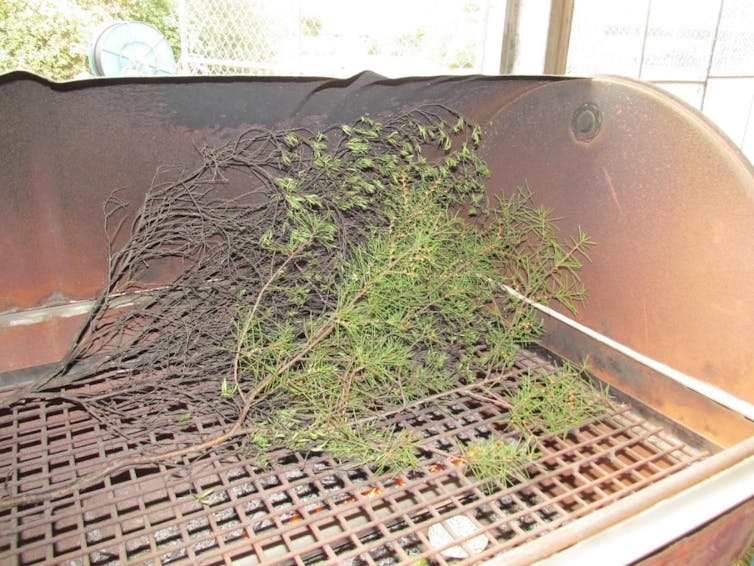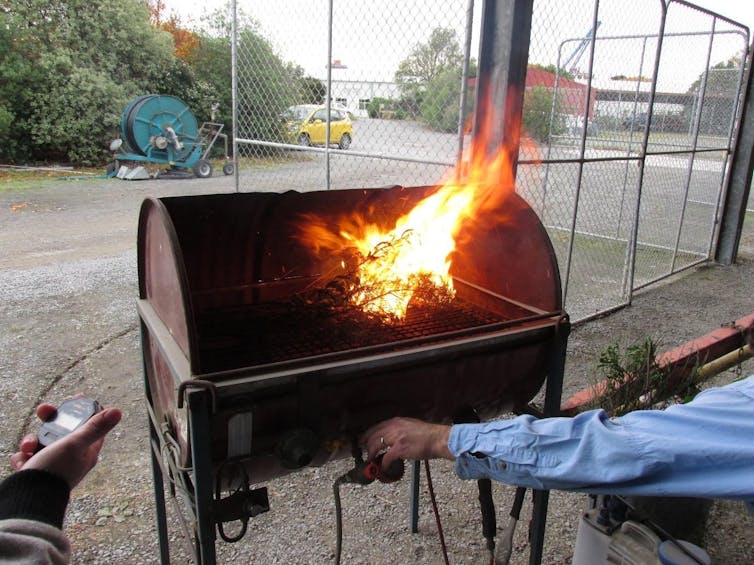How invasive weeds can make wildfires hotter and more frequent
- Written by Tim Curran, Senior Lecturer in Ecology, Lincoln University, New Zealand
Over the past year the global media has been full of reports of catastrophic fires in California, the Mediterranean, Chile and elsewhere. One suggested reason for increases in catastrophic wildfires has been human-induced climate change. Higher temperatures, drier weather and windier conditions all increase the impact of fires.
While climate change indeed raises the risk of wildfires, our research shows that another way humans can change patterns of fire activity is by introducing flammable plants to new environments.
Read more: How will Canada manage its wildfires in the future?
Plantations of highly flammable exotic species, such as pines and eucalypts, probably helped to fuel the recent catastrophic fires in Portugal and in Chile. In arid regions, such as parts of the US southwest, the introduction of exotic grasses has transformed shrublands, as fires increase in severity.
Invasive plants and fire
How do invasive plants change fire patterns? We burned species mixtures (aka “mixed grills”) on our plant barbecue to help find out.
Invasive plants are responsible for changing the patterns of fire activity in many ecosystems around the world. In particular, invasive species can lead to hotter and more frequent fires.
Invasive plants can also reduce fire frequency and fire intensity, but there are fewer examples of this occurring worldwide.
One of the main ways flammable invasive plants can have long-lasting impacts on an ecosystem comes from positive fire-vegetation feedbacks. Such feedbacks can occur when a flammable weed invades a less fire-prone ecosystem. By changing the available fuel the invader makes fires more likely and often hotter.
If the invading species has characteristics that allow it to outcompete native species after a fire, then it will further dominate the ecosystem. Such traits include thick bark, the ability to resprout following fire, or seeds that survive burning. This invasion will likely lead to more fires, changing the species composition and function of the ecosystem in a “fire begets fire” cycle. Extreme examples of this dynamic are where flammable grasses or shrubs invade forests, leading to loss of the forest ecosystems.
Mixed grills
We wanted to understand how invasive plants interact with other species when burned in combination. To explore the mechanisms underpinning such feedbacks, we examined how invasive plants might change the nature of a fire when burned together with native species.
We collected 70cm shoots of four globally invasive species (of both high and low flammability) and burned them in pairwise combinations with New Zealand native trees and shrubs to determine which characteristics of a fire could be attributed to the invasive plants.
 Samples of Hakea sericea (foreground) and Kunzea robusta (rear) arranged on the grill of our plant barbecue.
Sarah Wyse, CC BY-ND
Samples of Hakea sericea (foreground) and Kunzea robusta (rear) arranged on the grill of our plant barbecue.
Sarah Wyse, CC BY-ND
We found that overall flammability was largely driven by the most flammable species in the mixture, showing how highly flammable weeds could set in motion fire-vegetation feedbacks.
We established that a greater difference in flammability between the two species led to a larger influence of the more flammable species on overall flammability. This outcome suggests weeds that are much more flammable than the invaded community can have larger impacts on fire patterns.
Importantly, we also showed the influence of the highly flammable species was independent of its biomass, meaning highly flammable weeds may impact community flammability even at low abundances.
When we looked closer at the different components of flammability (combustibility, ignitability, consumability and sustainability) we found some important nuances in our results.
While the maximum temperature reached in our burns (combustibility) and the ignition speed (ignitability) were both most influenced by the more flammable species, consumability (the amount of biomass burned) and sustainability (how long the fire burns) were equally influenced by both the more flammable and less flammable species.
In short, more flammable weeds will cause a fire to ignite more quickly and burn hotter.
However, less flammable species can reduce the duration of a fire compared to when a more flammable species is burnt alone. These results could have important ecological implications, as the longer a fire burns the more likely it is to kill plants: low-flammability plants could reduce this impact.
 Measuring how long a fire burns on our plant barbecue.
Tom Etherington, CC BY-ND
Measuring how long a fire burns on our plant barbecue.
Tom Etherington, CC BY-ND
Managing weeds to reduce fire impacts
Even low abundances of highly flammable invasive weeds could set in motion positive fire-vegetation feedbacks that lead to drastic changes to ecosystems. If this result holds when our shoot-scale experiments are repeated using field trials, then land managers should work quickly to remove even small infestations of highly flammable species, such as gorse (Ulex europaeus) and prickly hakea (Hakea sericea).
Conversely, the role of low flammability plants in extinguishing fires further supports the suggestion that the strategic planting of such species across the landscape as “green firebreaks” could be a useful fire management tool.
In any case, our “mixed grill” study further highlights the role of exotic plants in fuelling hotter wildfires.
Authors: Tim Curran, Senior Lecturer in Ecology, Lincoln University, New Zealand
Read more http://theconversation.com/how-invasive-weeds-can-make-wildfires-hotter-and-more-frequent-89281





